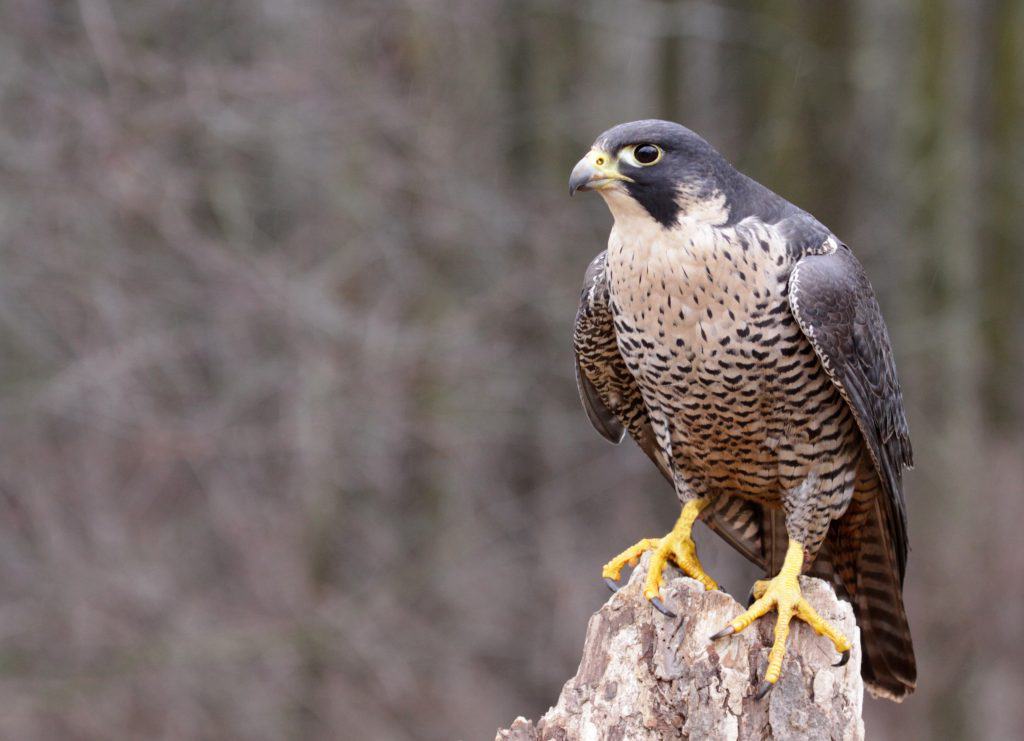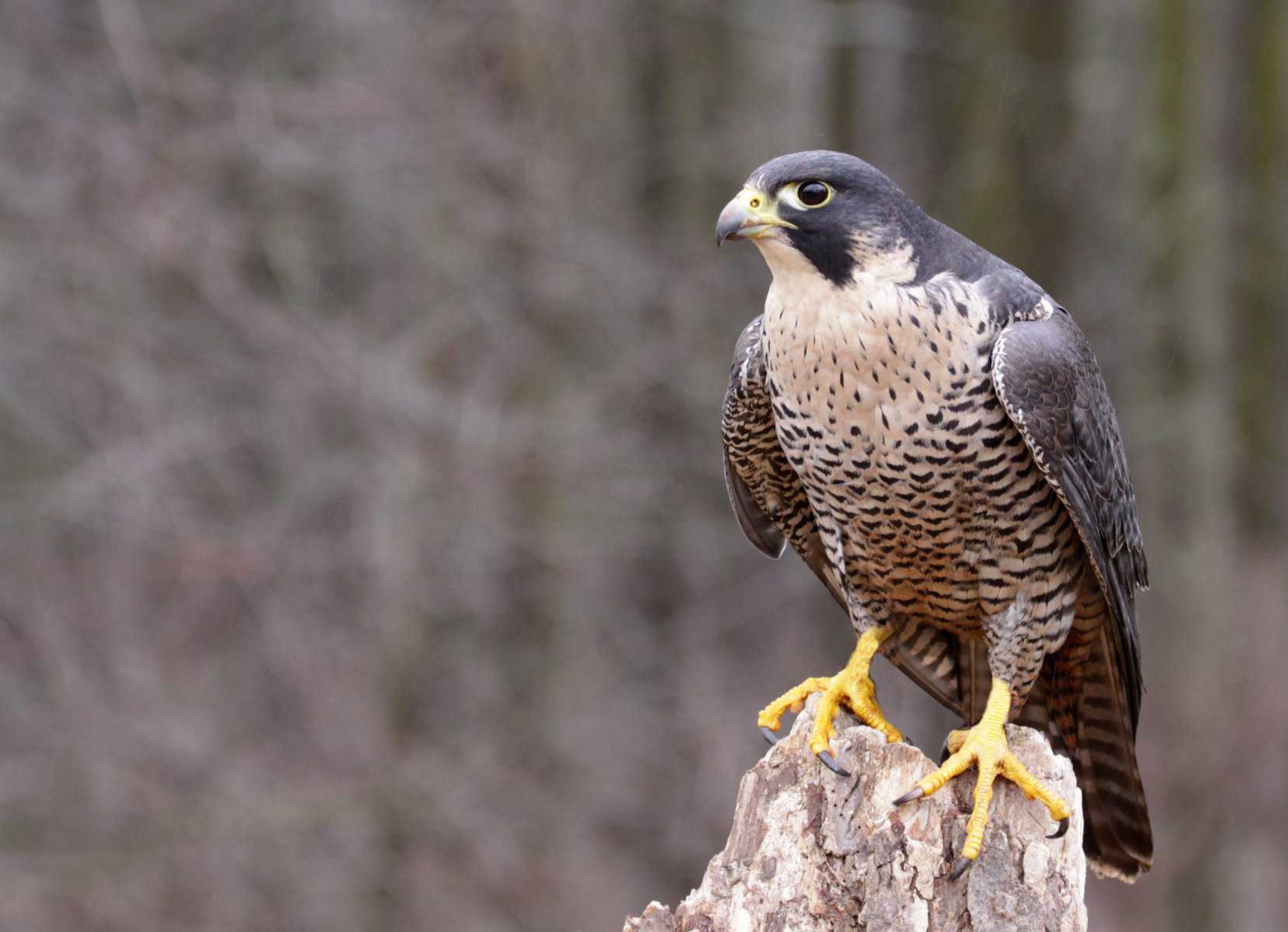Maine’s Acadia National Park is home to a diverse range of wildlife. Among the park’s most notable inhabitants are the peregrine falcons, a magnificent species of bird of prey known for their incredible speed and agility.
These birds, once on the brink of extinction, have made a remarkable recovery thanks to the conservation efforts of the National Park Service and other organizations. We will explore the history and current state of the peregrine falcons of Acadia National Park as well as their role in the park’s ecosystem and the ongoing efforts to protect them.

History of Peregrine Falcons in Acadia National Park
The peregrine falcons were once a common sight in Acadia National Park, but their numbers began to decline in the mid-20th century due to the widespread use of pesticide. Scientists concluded that pesticides were causing the shells of the falcon eggs to thin and break before they could hatch. This led to a drastic decline in the population of the birds across North America. By the 1960s, the peregrine falcon population in Acadia had dwindled to just one pair.
In response to this decline, the National Park Service launched an effort to save the falcons.
The peregrine falcon population in Acadia National Park was restored through a combination of captive breeding and habitat restoration efforts. Wildlife biologists began a program of captive breeding and release in which peregrine falcons were bred in captivity and then released into the wild in suitable habitat.
In Acadia National Park, biologists constructed artificial nesting sites, or “hack sites,” on cliffs and other high places to provide suitable nesting habitat for the falcons. Chicks were raised in these hack sites and then released into the wild when they were ready to fly.
In addition to the captive breeding program, the use of pesticides was banned, which helped to reduce the threat to peregrine falcon populations.
Thanks to these efforts, the peregrine falcon population in Acadia National Park has made a remarkable recovery. Today, visitors to the park can observe these magnificent birds of prey in their natural habitat soaring through the skies above the rocky cliffs and forests of the park.
Ongoing Conservation Efforts for Peregrine Falcons

Over the years, the National Park Service and other organizations have continued to work tirelessly to protect the peregrine falcons of Acadia National Park. These efforts have included monitoring, habitat restoration, and public education.
The park service has banded hundreds of peregrine falcons in the park, allowing them to track the birds’ movements and study their behavior.
One of the main threats to peregrine falcons in Acadia and other areas is human disturbance. Visitors to the park are encouraged to be aware of the presence of the birds and to keep a respectful distance from their nesting areas. Climbing and other activities on cliffs where peregrine falcons are known to nest are restricted during breeding season to minimize disturbance.
The park service have worked to restore and protect the habitats that the peregrine falcons depend on such as cliffs and rocky outcrops. For example, during nesting season Acadia Park officials will temporarily close trails such as the famous “Precipice” in order to protect nesting sties from visitor intrusions.
The park service has also invested in public educational programming about the importance of protecting peregrine falcons and other wildlife in the park, and they have encouraged visitors to report sightings of the birds.
As a result of these conservation efforts, the peregrine falcon population in Acadia National Park has made a remarkable recovery. Today, there are over a dozen pairs of peregrine falcons that call the park home, and they can be seen soaring and diving over the cliffs and coastline of the park.
Role of Peregrine Falcons in Acadia National Park
The peregrine falcons play an important role in the ecosystem of Acadia National Park. As top predators, they help to keep the populations of other species in check. This behavior is crucial for maintaining a healthy balance in the ecosystem. They also help to control the populations of smaller bird species that can have a negative impact on the park’s vegetation.
In addition to their ecological role, the peregrine falcons are also a beloved and iconic species in the park. Visitors to Acadia National Park can often be seen observing the birds with binoculars and cameras, marveling at their speed and grace as they fly overhead.
How to Spot a Peregrine Falcon in Acadia National Park
To spot and identify peregrine falcons in Acadia National Park, visitors should look for them in their preferred habitat: high cliffs and rocky outcroppings.
Peregrine falcons are known for their distinctive shape and markings, with long pointed wings and a dark head that contrasts with a pale breast. They are also very fast and agile, capable of reaching speeds of up to 240 miles-per-hour when in a dive.
When searching for peregrine falcons, visitors can look for them perched on cliff ledges or flying overhead. In flight, these falcons often exhibit swift and direct flight patterns.
The best time to spot them is during the breeding season, March through July, when they are most active and visible. Visitors should also be mindful of park regulations and stay at a safe distance from the birds so as not to disturb their natural behavior. Visitors should also be aware that male peregrine falcons do not like people above them and may dive at people to deter this behavior. It us unlikely to be an issue outside of nesting season.
The recovery of the peregrine falcon population in Acadia National Park is a success story of conservation efforts, demonstrating the resilience of these magnificent birds and the effectiveness of measures to protect them. Through the tireless work of the National Park Service and other organizations, the peregrine falcons of Acadia National Park have made a remarkable recovery and continue to thrive in their natural habitat.
As visitors to the park, we have a responsibility to respect these amazing creatures and to support ongoing efforts to protect them and their ecosystem. If you would like to help support the peregrine falcons of Acadia National Park, consider supporting Friends of Acadia National Park.
If you’re planning a visit to Acadia National Park, be sure to keep an eye out for the peregrine falcons, one of the park’s most fascinating inhabitants. With their incredible speed and agility, they are a thrilling sight to see and a reminder of the importance of protecting and preserving the natural world for generations to come. For other fun, family activities in Acadia National Park check out THIS post!

